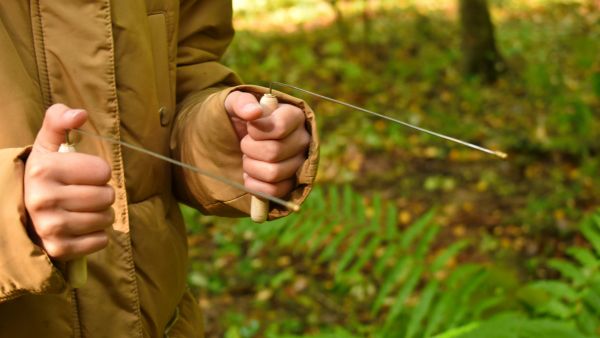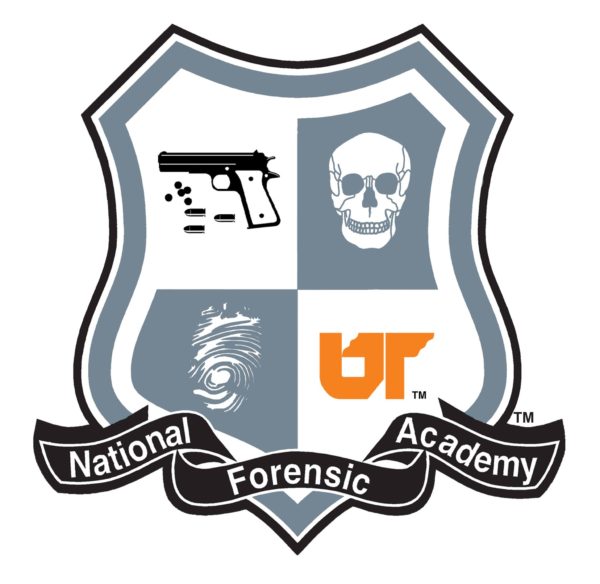
“Water witches” have traditionally used dowsing rods to find water. The practice goes by many names, including simply “dowsing” or by more colorful monikers like “doodlebugging” or “water witching.”
But water isn’t the only thing some say dowsing rods can locate. As the Farmers’ Almanac put it, “some practitioners use this technique to find all sorts of things: gold, bombs, or even the missing remote control to the TV.” Wikipedia added a few more items to the list, including gemstones, oil, and gravesites.
It’s that last one, gravesites, that’s of particular interest. Dowsing is a form of divination generally considered to be a pseudoscience because studies have shown dowsers don’t perform any better than random chance in controlled studies.
Yet, an instructor at the National Forensic Academy in Oak Ridge, Tennessee, teaches “witching” to students interested in learning how to dowse for the dead.

Detecting Death
The instructor’s name is Arpad Vass and finding ways to detect death and find dead bodies seems to be his specialty. Rene Ebersole wrote about him in a fascinating article for The Marshall Project, which was published in partnership with Mother Jones.
Vass is a smart guy. In addition to being one of the instructors at the National Forensic Academy, an intensive 10-week training program in evidence identification, collection, and preservation for law enforcement agencies, he used to work at the Oak Ridge National Laboratory. Prior to the Casey Anthony trial, that is, at which he testified and which he says ended his career at the lab. He was an expert for the prosecution who said an air sample from Casey Anthony’s trunk “revealed high levels of compounds consistent with human decomposition.”
The trouble was, an expert for the defense said Vass’s “testimony wasn’t backed up by scientific evidence and that many of the compounds Vass identified could have been emitted by food wrappers and other trash recovered from Anthony’s trunk.” There was a lot that legal experts pointed to contributing to Casey Anthony’s acquittal, but this was one of the biggies.
The thing is, Vass’s inventions demonstrate his out-of-the-box thinking. Take his Light-Weight Analyzer for Buried Remains and Decomposition Odor Recognition (LABRADOR) device, which is “meant to help detect those compounds better than a cadaver dog.” It wasn’t produced or used on a commercial level, but the concept is fascinating.
So was his “fly on a leash” idea. Flies are nature’s death-finders. As Orkin explains, flies are “attracted to decaying meat and are typically the first organisms to come into contact with dead animals.” Vass came up with an idea to attach miniature trackers to the insects and then let them lead to the bodies. The trouble was the food chain.
“It would have worked great. But birds eat flies. I lost most of my trackers,” as The Marshall Project article quoted him.
Even though he’s a man of science and invention, he’s also willing to entertain low-tech ideas for finding bodies.
Dowsing for the Dead
Vass contends there’s a certain way to use the rods. Walking at a certain pace is essential. (I’m assuming the Goldilocks pace, not too fast or not too slow, but the article didn’t specify.)
It did elaborate on why dowsing rods may work. Vass theorizes that metal rods can detect “piezoelectricity,” which Wikipedia defines as “the electric charge that accumulates in certain solid materials—such as crystals, certain ceramics, and biological matter such as bone, DNA, and various proteins—in response to applied mechanical stress.”
Ebersole attended a class where Vass demonstrated his dowsing rod technique by putting a cow bone on the floor and walking over it. As predicted, the rods crossed.
Students had plenty of questions about it, like why didn’t the rods detect the living people in the room? Vass said the electric field dissipated through the water and moisture in skin, weakening the charge so the rods wouldn’t detect it.
They also wondered if courts would accept finding a body using this method. One of Vass’s former students used “witching” to find bone fragments in a case in Georgia and it was admitted.
This is what troubles a lot of other experts in the field, including professional forensic anthropologists, lawyers, and law enforcement officers advocating police training reforms. Is the esteemed National Forensic Academy, touted as “the Harvard of Hellish Violence” by the Washington Post, really teaching such a pseudoscience technique?
Apparently, yes. But is it really pseudoscience, or is there something to it?
The Ideomotor Phenomenon
Here’s what I would’ve asked if I was a student in Vass’s class: “But does it work if you don’t know where the bone is?” If anyone did, the article didn’t say. I’d have been a lot more impressed if he let the students hide the bone and he demonstrated finding it.
Which is why the skeptic in me chalked up the rods crossing to the power of suggestion. But there’s an even more accurate term scientists use to explain this sort of thing, the “ideomotor phenomenon” or effect, which is when “suggestions, beliefs, or expectations cause unconscious muscular movements.”
This effect is also attributed to other alleged paranormal activity, including what’s really moving planchettes on Ouija boards.
No studies have proven that dowsing rods work. Ebersole questioned him about one study in particular conducted by scientists from the FBI laboratory, George Mason University, and the U.S. Army Criminal Investigation Command that was published in 2021. One group was asked to look at nine holes and ascertain which may contain bodies. Another group used dowsing rods. Neither method worked.
Vass says that’s because those using the dowsing rods weren’t experienced using them. He says he’s identified “17 scientific principles that make the rods work” and teaches students to use them properly.
However, it all may be a moot point because he’s developed something that’s supposed to be even better.
The Vass Oscillator
Vass has abandoned using dowsing rods in favor of a “quantum oscillator” that he invented. It’s based on the idea that everything, from precious metals to our DNA, emits a specific frequency. When you put some kind of DNA in his oscillator, like blood, hair, or nail clippings, and “beam” it out to the environment, it will get “excited” and “re-radiate” the signal back when it finds a match of the same frequency.
Like his LABRADOR device, he’s not producing it or selling it commercially. It’s already been used in some cases, though, but with mixed results. So whether it really works or not remains to be seen.
He seems as cocky as he is brilliant but at the end of the day, he’s trying something different. If he ends up hitting on a method that finds missing bodies and brings closure to families and maybe even convictions in murder cases, that’s what really counts.
Although, I also can’t help but think that in addition to finding dead bodies, he also might be the kind of person to come up with a way for finding ghosts too. Wonder if he’s ever considered that too? He’d definitely be interesting to talk with about paranormal investigations and the equipment used on them.
Check-In
Have you ever used dowsing rods?
Courtney Mroch is a globe-trotting restless spirit who’s both possessed by wanderlust and the spirit of adventure, as well as obsessed with true crime, horror, the paranormal, and weird days. Perhaps it has something to do with her genes? She is related to occult royalty, after all. Marie Laveau, the famous Voodoo practitioner of New Orleans, is one of her ancestors. That could also explain her infatuation with skeletons.
Speaking of healing, to learn how she channeled her battle with cancer to conjure up this site, check out HJ’s Origin Story.

I tried them, once, when I was younger. Or, I tried to try them. But, you know, ADHD and the patience they require aren’t a good mix. Ha!
LOL! You crack me up!